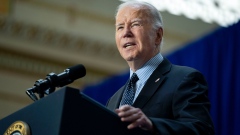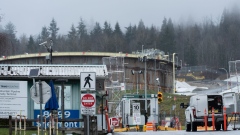Oct 13, 2022
Trudeau wants to catch up with Biden on clean-energy tax credits
, Bloomberg News
Damages from climate events are dragging down the economy: Economist
Prime Minister Justin Trudeau’s government has begun crafting plans to even the playing field with the U.S. on investment incentives for carbon capture and other clean energy projects.
Finance Minister Chrystia Freeland and Natural Resources Minister Jonathan Wilkinson, among others, are working on a response ahead of a fiscal update due in coming months, according to two government officials with knowledge of the matter.
The most likely scenario is for the government to signal its intentions next month or in early December, with a more detailed policy to come in a budget in the first half of 2023. The energy sector also believes that’s the most probable sequence, according to people familiar who spoke on condition of anonymity in order to discuss government deliberations.
“It’s urgent,” Michael Gullo, vice president for policy at the Business Council of Canada, said by phone. “There’s a race going on to attract billions of dollars of investment.”
Canada’s carbon capture tax credits were unveiled in Freeland’s budget last April, but industry groups have since been pressuring her to bring Canada’s incentives in line with more generous U.S. ones. They argue Canada risks falling far behind its neighbor in attracting the huge amount of capital needed to fund the technology.
Carbon-capture projects in the U.S. got a major boost in August with the passage of the Inflation Reduction Act. The legislation, which increased tax credits by 70 per cent to US$85 per ton of carbon dioxide, was welcomed by executives from Exxon Mobil Corp. and Occidental Petroleum Corp.
'MORE THAN DOUBLE'
The Canadian Association of Petroleum Producers, in a Sept. 29 submission to Freeland’s department, said the government’s incentives would have to “more than double” to match benefits U.S. investors will receive on equivalent projects.
The document -- sent during a government consultation on the final design of the credits -- warned that a carbon capture project built under Canada’s proposal “would not even meet its cost of capital,” while the same project built in the U.S. “would not only meet its cost of capital but would return positive cash flow.”
The credits adopted by President Joe Biden’s administration “will attract significant capital investment thereby outpacing Canada in its own national policy to reduce GHGs and create jobs,” the industry group said in its submission.
Canada is attempting to reach its goal of net zero emissions by 2050 without curtailing oil and gas production, meaning technology such as carbon capture will be crucial. The April budget earmarked $2.6 billion (US$1.9 billion) over the next five years for carbon capture incentives, and then about $1.5 billion annually until 2030.
However, the proposed tax credits will cover 50 per cent of equipment costs for most projects, and 37.5 per cent for other costs around transportation, storage and use. That compares to the new U.S. tax credits that will cover about 85 per cent of costs, and which industry groups argue are more flexible and apply more broadly.
It isn’t known yet whether Trudeau’s government is willing to put substantially more money on the table.
The prime minister, asked this week about the U.S. legislation, confirmed the government is working on a response.
“We’re going to take further steps to make sure we continue to be competitive as a country that the world wants to come and invest in,” Trudeau told reporters Tuesday after he announced funding to boost critical minerals production in Quebec.
One factor is whether Alberta -- the main oil-and-gas producing province -- enacts its own incentives, which would help close the gap with the U.S. It has been in political turmoil since the spring, when Jason Kenney resigned as premier and kicked off a leadership race culminating the last week’s election of Danielle Smith as his successor.
Government officials also believe that Canada’s overall climate policies, such as the national carbon price and a range of grants and incentives already in place for net-zero projects, make it misleading to compare only the investment tax credits.
But if it wants to keep pace with the U.S., Canada must also look at incentives and government funding for other clean energy projects such as hydrogen, according to Gullo.
“There has to be strong collaboration between the industry and governments to move these types of multibillion-dollar projects forward,” he said. “This is in the national interest.”








